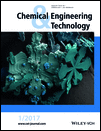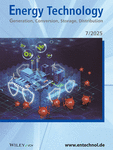Journal list menu
Export Citations
Download PDFs
Cover Picture
Editorial Board
Overview
Highlights
Review
Molecular Dimensions and Porous Structure of Activated Carbons for Sorption of Xylene and Isooctane
- Pages: 6-17
- First Published: 13 September 2016

Activated carbons are of significant technological interest as low-cost adsorbents with high efficiency to adsorb hazardous volatile organic compounds. Two types of commercially produced activated carbons were investigated for adsorption of the two model volatile organic compounds isooctane and xylene. Mesopore surface area and surface basicity were the key factors for adsorption capacity.
Research Articles
Boil-Off Gas Two-Stage Compression and Recondensation Process at a Liquefied Natural Gas Receiving Terminal
- Pages: 18-27
- First Published: 15 August 2016

Boil-off gas (BOG) is constantly generated from a liquefied natural gas storage tank, resulting in safety risks such as system vibration. A BOG two-stage compression and recondensation process was designed based on the original process and optimized through dynamic simulation. The two-stage process eliminates system vibration, provides better operation stability and reduces energy consumption.
Method for Characterization of Solvents for Physical Absorption Processes
- Pages: 28-38
- First Published: 15 August 2016

A method for the characterization of solvents and additives for physical absorption processes is introduced to support the search for such substances. Thus, a model based on the concept of virtual components and an abstract flow sheet is successfully validated and applied in two studies including the search for an additive. The model is highly flexible and can easily be adapted to new problems.
Simplified MATLAB Solution Schemes of Heat Transfer Equations
- Pages: 39-49
- First Published: 22 August 2016

Heat transfer operations are controlled by simulations required to be as close to the real world as possible. Here, problems in heat transfer are addressed using finite difference solution specially developed using MATLAB. These solution schemes can easily be extended to momentum and mass transport operations in similar situations.
Potassium-Activated Wire Mesh: A Stable Monolithic Catalyst for Diesel Soot Combustion
- Pages: 50-55
- First Published: 25 August 2016

A new catalytic diesel particulate filter suppresses the emission of soot from a diesel engine. A monolithic catalyst for diesel soot combustion is formed by in situ potassium deposition on FeCrAl alloy wire mesh. A stable layer of K-O-Al species forms by precalcination and the catalyst lowers the initial temperature of soot combustion and maintains the activity in cyclic tests.
Measurement of Micro Kinetics of Hydrogenation in Liquid Phase Using Raman Spectroscopy
- Pages: 56-63
- First Published: 06 October 2016

Liquid organic hydrogen carriers are usually hydrogenated in liquid phase. An experimental setup for measuring the hydrogenation kinetics with in situ Raman spectroscopy is proposed. For validation of this setup, the kinetics of 1-octene was measured and the reaction parameters were determined. Modeling was done by the classical kinetic model and a thermodynamic kinetic model.
Characterization and Modeling of Oxygen Transfer in a Spouted-Bed Reactor with Auxiliary Aeration
- Pages: 64-70
- First Published: 06 October 2016

The oxygen mass transfer rate in a draft-tube spouted-bed (DTSB) reactor equipped with both central and lateral aeration was investigated. The attained high availability of dissolved oxygen in the annulus is particularly advantageous for aerobic DTSB bioreactors. An empirical equation was developed to estimate the oxygen transfer coefficient kLa as a function of the total air flow rate.
An Innovative Technique for Rapid Screening of Cigarette Filter Adsorbents
- Pages: 71-75
- First Published: 30 August 2016

An innovative screening tool named InfraSorp for the rapid evaluation of toxicant reduction by porous filter materials is introduced. Based on the optical detection of released heat during the adsorption of toxic molecules, reliable information is obtained within a few minutes with good correlation between the InfraSORP measurements and the reference cigarette smoke filter experiments.
Role of Organic Acids in Flux Enhancement of Polyamide Nanofiltration Membranes
- Pages: 76-87
- First Published: 08 September 2016

The effect of added organic acids on the performance of polyamide thin-film composite nanofiltration membranes was investigated. Organic acids as interfacial polymerization aqueous-phase additives enhanced membrane morphology and hydrophilicity. The carboxylic acid functional groups in the additives led to high porosity without changing the membrane pore size and significantly higher flux.
Mechanochemical Synthesis of CPM-5: A Green Method
- Pages: 88-93
- First Published: 09 September 2016

As an example of green technology, a mechanochemical synthesis of the crystalline porous material CPM-5 was developed using a mixer mill. The effects of different parameters on the synthesized products including grinding conditions, thermal treatment, as well as washing with different solvents were studied. Both post-synthesis treatments significantly enhanced the process.
Carbon Membranes Prepared from a Polymer Blend of Polyethylene Glycol and Polyetherimide
- Pages: 94-102
- First Published: 09 September 2016

Carbon membranes were prepared by carbonization of the thermally stable polyetherimide blended with the thermally labile polyethylene glycol and experimentally characterized. Permeation tests with single gases revealed that the addition of polyethylene glycol to the blend enhanced both the gas permeabilities and ideal selectivities of the produced carbon membranes.
Effect of Shear Work on the Heat Transfer Characteristics of Gaseous Flows in Microchannels
- Pages: 103-115
- First Published: 06 July 2016

A theoretical attempt has been made to study the influence of second order velocity slip, temperature jump, viscous dissipation, and shear work on heat transfer characteristics of gaseous flow through micropipe/parallel plate geometries. The effect of rarefaction on temperature distribution is significant in the presence of viscous dissipation and a higher value of the Nusselt number is predicted compared to the model that neglects shear work.
Dustiness Quantification of Powders by the Fractional Release Rate
- Pages: 116-121
- First Published: 13 September 2016

Dustiness is an important process-related product property of dispersed solids. A so-called fractional release rate to quantify the raise of dust particles into the air is introduced. The proposed model can plausibly predict the release of dust particles from agitated powders. Its application is demonstrated by a simple example assuming reasonable values for binding and separating forces.
Comparison of Response Surface Methodology and Artificial Neural Network for Modeling Xylose-to-Xylitol Bioconversion
- Pages: 122-129
- First Published: 21 September 2016

A dataset from a full factorial design used to evaluate the influence of four independent variables on xylose-to-xylitol bioconversion was used to get different network architectures by two training methods (tenfold cross-validation and training/testing). An artificial neural network was compared to response surface methodology to optimize the process using a genetic algorithm.
Static and Dynamic, but not Pulsed High-Pressure Treatment Efficiently Inactivates Yeast
- Pages: 130-137
- First Published: 05 October 2016

Recurring pressure cycles are an innovative development of existing high-pressure treatments of food and pharmaceuticals. The effects of static, pulsed, and dynamic pressure profiles on the yeast S. cerevisiae are described. Cell membrane damage and inactivation efficiency increase with pressure and holding time, but the cells show no higher sensitivity to repeated and fast depressurization.
Microbubble Generation with the Aid of a Centrifugal Pump
- Pages: 138-144
- First Published: 06 October 2016

The separation of oil from water during waste water treatment is of great environmental concern. Dissolved air flotation is a promising technique for liquid-liquid separation, but rather costly. Here, a microbubble production technology using only a centrifugal pump is introduced. This strategy reduces the cost of conventionally used equipment and the physical space required.
Artificial Neural Network Modeling of Hydrodynamics of Liquid-Solid Circulating Fluidized Beds
- Pages: 145-152
- First Published: 12 October 2016

Solids holdup and circulation rate are two important hydrodynamic variables influencing the performance of liquid-solid circulating fluidized beds. An artificial neural network methodology was developed and simulated in order to predict the performance of such fluidized beds. As confirmed by model validation, this data-driven technique can be successfully applied to model such nonlinear systems.
Methods for the Trace Oxygen Removal from Methane-Rich Gas Streams
- Pages: 153-161
- First Published: 06 December 2016

Oxygen removal to trace amounts in methane-rich gas streams containing carbon dioxide as co-component was achieved by three different processes. Their characteristic advantages and disadvantages are discussed and compared to existing gas treatment methods for oxygen removal. Dielectric radio-frequency heating on the powdered functional materials is proposed as alternative to conventional routes.
Experimental Characterization of a Flow-through Pulsation Damper Regarding Pressure Pulsations and Vibrations
- Pages: 162-169
- First Published: 19 October 2016

Hydraulic attenuators are frequently applied to prevent undesired pressure pulsation levels in pump circuits. The performance of a flow-through accumulator in an industrial-scale test rig is investigated with respect to pressure pulsations and pipe vibrations. The influence of varying pulsation frequencies, damper precharge pressure, and damping effect throughout the piping system is analyzed.
Spilled-Oil Sorbents Prepared by Recycling of Eutrophicated Aquatic Plants
- Pages: 170-176
- First Published: 19 October 2016

Four eutrophicated aquatic plants were evaluated as natural spilled-oil sorbents. They exhibit superior sorption capacity and can be recycled more than ten times. The rapid oil sorption process and good reusability are of significant practical importance and make these plants well-suited as highly effective, low-cost, and environment-friendly spilled-oil sorbents.
Design Parameters for Performing Circulating Turbulent Fluidization with a Single Feed Stage Fluidized Bed Reactor
- Pages: 177-185
- First Published: 19 October 2016

Specific design of a fluidization reactor allows the possibility of performing circulating turbulent fluidized bed (CTFB) by using only single feed gas injection. The design parameters are studied based on the Geldart classification and Archimedes number. The effect of the operating parameters is revealed by manipulating the solid recirculation rates.
Procedural Rate Enhancement of Lean Aqueous Hydroformylation of 1-Octene without Additives
- Pages: 186-195
- First Published: 19 October 2016

To underline the importance of procedural rate enhancement of multiphase reactions, the biphasic solvent- and additive-free aqueous hydroformylation of the mid-chain olefin 1-octene with different stirring techniques is investigated. The reaction rates can be doubled by improving the mixing technique. A linear relation between catalytic activity and created interfacial areas is observed.
Recycling and Oligomerization Activity of Ni/Al Catalyst in a Biphasic System with Ionic Liquids
- Pages: 196-204
- First Published: 19 October 2016

Many reactions are catalyzed by expensive homogeneous transition-metal complexes. This is one reason why there is interest in recycling the catalyst. The decomposition of catalyst [NiCl2(PMe3)2] has been studied for the oligomerization of n-butenes. Recycling experiments indicated that this catalyst is viable for five runs. Introducing aluminum chloride or an ionic liquid increases the stability.










